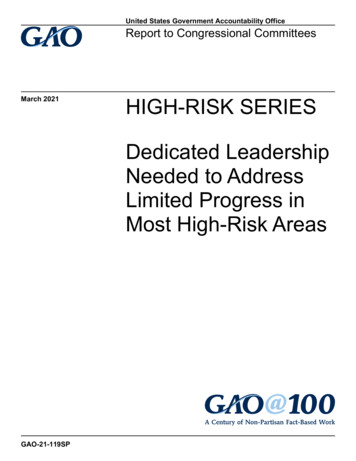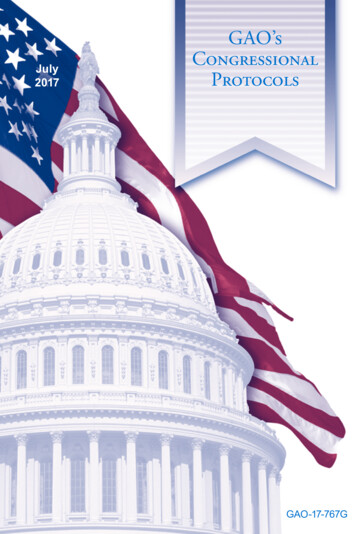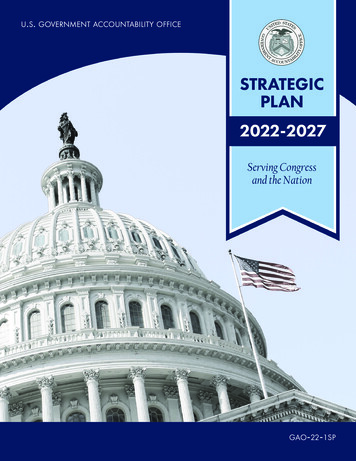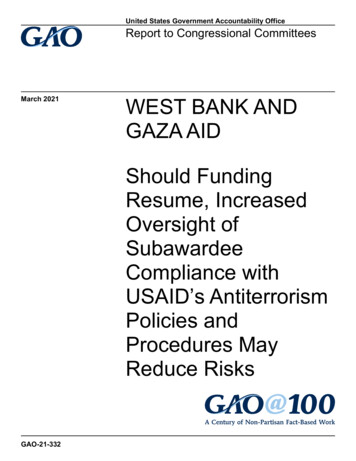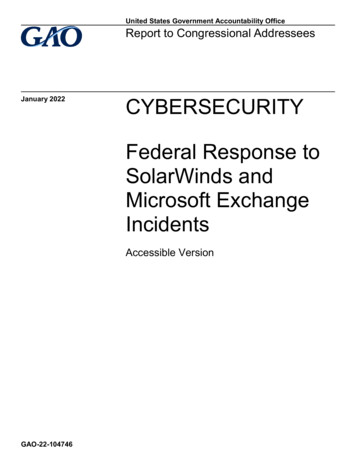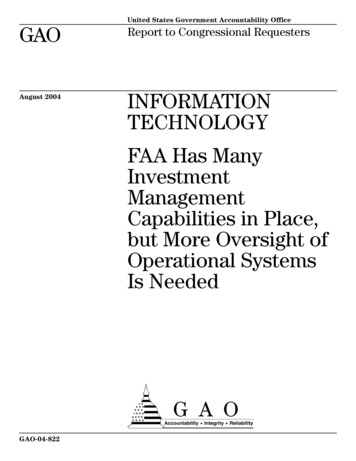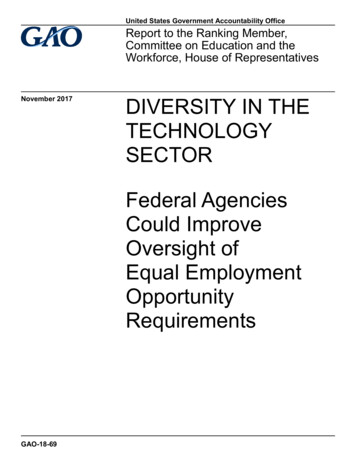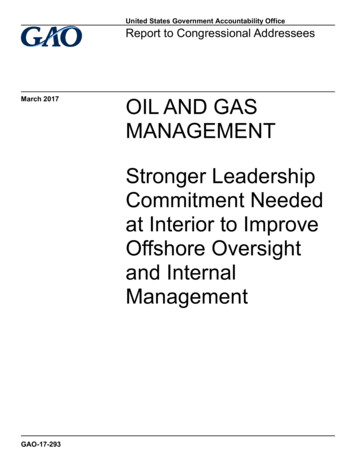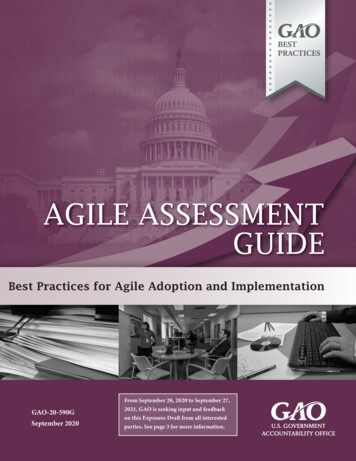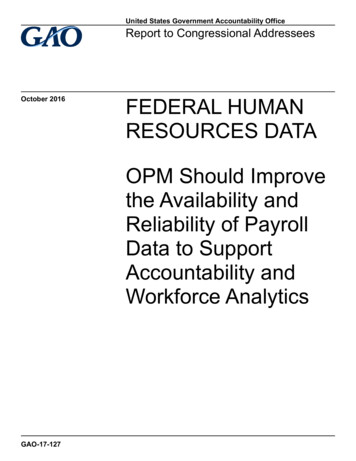
Transcription
United States Government Accountability OfficeReport to Congressional AddresseesOctober 2016FEDERAL HUMANRESOURCES DATAOPM Should Improvethe Availability andReliability of PayrollData to SupportAccountability andWorkforce AnalyticsGAO-17-127
October 2016FEDERAL HUMAN RESOURCES DATAHighlights of GAO-17-127, a report tocongressional addresseesOPM Should Improve the Availability andReliability of Payroll Data to SupportAccountability and Workforce AnalyticsWhy GAO Did This StudyWhat GAO FoundOPM is tasked with supporting federalagencies’ human capital managementactivities, which includes ensuring thatagencies have the data needed tomake staffing and resource decisionsto support their missions. The EHRIsystem is OPM’s primary datawarehouse to support these efforts.The payroll database—one of the fourdatabases in the EHRI system—became operational in 2009. Payrolldata provide information on federalemployees’ pay and benefits and howthey allocate their time, as reflected inhours charged to work activities anduse of leave. EHRI data are essentialto governmentwide human resourcemanagement and evaluation of federalemployment policies, practices, andcosts. The ability to capitalize on thisinformation is dependent, in part, onthe reliability of the collected data.The Enterprise Human Resources Integration (EHRI) payroll data are not fullysupporting the Office of Personnel Management’s (OPM) strategic and opendata goals. This is because OPM has not taken the steps necessary to make thedata widely available for use by other agencies and researchers. EHRI payrolldata are intended to provide a centralized, standardized, and comprehensivesource of pay and leave related data across the federal government. In thiscapacity, these data have the potential to provide a more efficient, cost effective,and precise data source for federal agencies and researchers who wish toassess human resources and policy decision making across the federalgovernment. Because these data are not widely available, federal agencies andresearchers must rely on other proxy sources for payroll data, which are morelimited in the scope of analysis they can provide or the level of detail needed fordata-driven human capital studies.GAO undertook this review to examinethe extent to which (1) EHRI payrolldata have supported OPM's strategicand open data goals and (2) internalcontrols are in place to assure thereliability of the data. GAO reviewedliterature, interviewed officials andreviewed documents from OPM andthe payroll Service Centers, comparedOPM’s data quality processes toGAO’s Standards for Internal Control,and performed electronic tests of thepayroll data.What GAO RecommendsGAO is making five recommendations,including that OPM improve theavailability of its payroll data andimplement additional internal controlactivities to better ensure datareliability.OPM agreed with all of GAO’srecommendations.Although some elements of the data are sufficiently reliable for general use,weaknesses in OPM’s internal controls for the EHRI payroll data will need to beaddressed to enhance the reliability of other data elements. As shown in thetable below, GAO’s assessment of key internal control activities that are criticalto ensuring the reliability of the EHRI payroll data found a number of areas wherethere is insufficient assurance that the control objective will be achieved. Theseweaknesses increase the risk of data errors, incomplete data fields, andineffective monitoring of the EHRI payroll data. Unless OPM takes steps tocorrect these internal control weaknesses, it will be unable to fully leverage thesedata to meet its mission and allow others to make full use of these data for theirresearch needs.Assessment of Selected Internal Control Activities for Enterprise Human ResourcesIntegration (EHRI) Payroll DataInternal Control AttributesManagement designs control activities over the informationtechnology infrastructure to support the completeness, accuracy,and validity of information processing by information technology.Management designs control activities to limit user access toinformation technology through authorization control activities.Management designs appropriate types of control activities, suchas for appropriate documentation of transactions and internalcontrols.Management performs ongoing monitoring of the design andoperating effectiveness of the internal control system as part of thenormal course of operations.Management evaluates and documents the results of ongoingmonitoring and separate evaluations to identify internal controlissues.DesignImplementation Source: GAO Analysis of OPM information GAO 17-127 Reasonable assurance control objective will be achieved Insufficient assurance control objective will be achievedView GAO-17-127. For more information,contact Nancy Kingsbury at (202) 512-2700 orkingsburyn@gao.gov.United States Government Accountability Office
ContentsLetter1BackgroundOPM Has Not Made EHRI Payroll Data Widely Available EvenThough They Have Potential to Support OPM’s Strategic andOpen Data GoalsWeaknesses in Internal Controls Complicate OPM’s Ability toLeverage EHRI Payroll Data in Support of Its MissionConclusionsRecommendations for Executive ActionAgency Comments and Our Evaluation622323333Appendix ISelected Data Reliability Testing Results35Appendix IIStandards and Methods for Data Reliability Assessment41Appendix IIIComments from the Office of Personnel Management43Appendix IVGAO Contact and Staff Acknowledgments4611TablesTable 1: Assessment of Selected Internal Controls for EnterpriseHuman Resources Integration Payroll DataTable 2: Payroll Data Edit Rules: Excerpts from the Office ofPersonnel Management Guide to Human ResourcesReportingTable 3: Number of Pay Periods with Missing Data for the 24 CFOAct Agencies, Fiscal Year 2014Table 4: Entities Excepted from Enterprise Human ResourcesIntegration (EHRI) Reporting that are Included in EHRIPayroll Data, by Fiscal YearTable 5: Social Security Numbers Associated with More than OneEnterprise Human Resources Integration Records, byFiscal YearTable 6: Percent and Number of Missing Records for TeleworkRelated Fields in the EHRI Payroll DataPage i232425293035GAO-17-127 Federal Human Resources Data
Table 7: Percent and Number of Records Indicating Use ofTelework in the EHRI Payroll DataTable 8: Complete Duplicate Records (All Fields the Same) in theEHRI Payroll DataTable 9: EHRI IDs Associated With More Than One SocialSecurity Number in the EHRI Payroll DataTable 10: Records with Multiple Payments Per Pay Period (AnyAgency) in the EHRI Payroll DataTable 11: Records with Multiple Payments Per Pay Period Withinthe Same Agency in the EHRI Payroll DataTable 12: Percent and Number of Selected Variables withQuestionable Values Given Acceptable Ranges andTolerances in the EHRI Payroll DataTable 13: Social Security Numbers with Invalid Formats in theEHRI Payroll DataTable 14: Minimum and Maximum Values Outside of ExpectedRanges in the EHRI Payroll Data39Figure 1: Flow of Time and Attendance Reporting Through PayrollService Centers to OPM’s Enterprise Human ResourcesIntegration Payroll Database936363737373839FigurePage iiGAO-17-127 Federal Human Resources Data
AbbreviationsATAAPSCSRSDCPSDFASDHSDOD NFCNPCOPMPPSBASSA IGSTARWebTAVAWebTATELWinTAYTDAutomated Time, Attendance, and Production SystemCivil Service Retirement SystemDefense Civilian Pay SystemDefense Finance and Accounting ServiceDepartment of Homeland SecurityDepartment of Defense Inspector GeneralBusiness Management RedesignEnterprise Human Resources IntegrationElectronic Time and Attendance Management SystemFederal Employee Group Life InsuranceFederal Employees Retirement SystemFederal Employee Viewpoint SurveyFederal Information System Controls Audit ManualGuide to Data Standards Part BGuide to Human Resources ReportingGeneral ScheduleGeneral Services AdministrationInterior Business CenterNational Finance CenterNational Payroll CenterOffice of Personnel Managementpay periodSmall Business AdministrationSocial Security Administration Office of Inspector GeneralWeb-based System for Time and Attendance Reportingtime and attendanceDepartment of Veterans AffairsWeb-based Time and Attendance Telecommunications LineWindows Time and Attendanceyear-to-dateThis is a work of the U.S. government and is not subject to copyright protection in theUnited States. The published product may be reproduced and distributed in its entiretywithout further permission from GAO. However, because this work may containcopyrighted images or other material, permission from the copyright holder may benecessary if you wish to reproduce this material separately.Page iiiGAO-17-127 Federal Human Resources Data
Letter441 G St. N.W.Washington, DC 20548October 7, 2016The Honorable Jason ChaffetzChairmanThe Honorable Elijah E. CummingsRanking MemberCommittee on Oversight and Government ReformHouse of RepresentativesData are essential for understanding the effectiveness and efficiency ofgovernment operations. Data can help determine whether federalagencies are accomplishing their missions, how efficiently, and at whatcost. 1 Agency officials also rely on data to manage their programs andinform human capital decisions. If these data are unreliable—incompleteor inaccurate—agencies risk making costly and uninformed decisions thatcan affect both agency operations and the public. Recognizing theimportance of available and reliable data to government operations andaccountability, we have made several recommendations in prior reportsfor data quality improvements across a wide range of federal programs.1Reliable performance data are necessary to track progress in achieving agencies’missions in compliance with GPRA Modernization Act of 2010 (GPRAMA) (GAO-15-788),reduce fragmentation, overlap, and duplication in federal government programs(GAO-15-404SP), and accurately report spending in compliance with the DigitalAccountability and Transparency Act (DATA) Act (GAO-15-241T). GAO, Managing forResults: Greater Transparency Needed in Public Reporting on the Quality of PerformanceInformation for Selected Agencies’ Priority Goals, GAO-15-788 (Washington D.C.; Sep2015); GAO, 2015 Annual Report: Additional Opportunities to Reduce Fragmentation,Overlap, and Duplication and Achieve Other Financial Benefits, GAO-15-404SP(Washington D.C.; Apr 2015). GAO, Federal Data Transparency: Effective Implementationof the DATA Act Would Help Address Government-wide Management Challenges andImprove Oversight, GAO-15-241T (Washington D.C.; Dec 2014).Page 1GAO-17-127 Federal Human Resources Data
These reports have highlighted the costs and risks of failing to collectaccurate data to manage and evaluate agency programs. 2One particularly important type of data for ensuring effective and efficientgovernment operations, as well as government accountability, is humanresources data, or information on the federal workforce itself. As we havepreviously noted, agencies must monitor workforce data to avoid serioushuman capital shortfalls, such as critical skills gaps, which can erode theirability to carry out their missions. 3 In addition, Congress, auditorganizations, policy groups, and others regularly use federal workforcedata to evaluate federal employment policies, practices, and costs. Auditorganizations use workforce data to detect and prevent fraud, waste, andabuse in government operations.The Office of Personnel Management (OPM) is tasked with supportingagencies’ human capital management activities, which includes ensuringthat agencies have the data needed to make staffing and resourcedecisions to support their missions. One of OPM’s strategic goals is to bethe federal leader in data-driven human resources analytics. To that end,OPM collects a variety of human capital data from federal agencies. TheEnterprise Human Resources Integration (EHRI) system is the primarydata warehouse to support these efforts. OPM designed EHRI to leverage2We have recommended data quality improvements in areas such as hospital qualitydata, airline safety, federal property management, trends in greenhouse gas emissions,and costs of federal activities such as telework and use of official time, among others.GAO, Hospital Quality Data: Issues and Challenges Related to How Hospitals SubmitData and How CMS Ensures Data Reliability, GAO-08-555T (Washington, D.C.: Mar2008). GAO, Aviation Safety: FAA Is Taking Steps to Improve Data, but Challenges forManaging Safety Risks Remain, GAO-12-660T (Washington, D.C.: Apr 2012). GAO,Federal Real Property: Better Guidance and More Reliable Data Needed to ImproveManagement, GAO-14-757T (Washington, D.C.: Jul 2014). GAO, Climate ChangeScience: High Quality Greenhouse Gas Emissions Data are a Cornerstone of Programs toAddress Climate Change, GAO-09-423T (Washington, D.C.: Feb 2009). GAO, HumanCapital: Telework Programs Need Clear Goals and Reliable Data GAO-08-261T(Washington, D.C.: Nov 2007). GAO, Labor Relations Activities: Actions Needed toImprove Tracking and Reporting of the Use and Cost of Official Time, GAO-15-9(Washington, D.C.: Oct 2014).3GAO, Human Capital: Update on Strategic Management Challenges for the 21st CenturyGAO-15-619T (Washington, D.C.: May 2015).Page 2GAO-17-127 Federal Human Resources Data
its existing IT infrastructure, staff, and tools to integrate federal personnel,payroll, training, and retirement databases. 4The payroll database—one of the four databases of the EHRI system—became operational in 2009. Payroll data provide information on howfederal employees allocate their time—reflected in hours charged tospecific categories of work and use of leave. Every two weeks,information for over two million federal civilian employees is transmitted toOPM from four payroll service centers and other, individual payrollproviders responsible for processing payroll transactions for federalagencies. Service centers standardize and collate certain fields inagencies’ time and attendance data in order to report specified fields tothe EHRI payroll database. These fields include unique identifiers, suchas an EHRI ID number, to link individual records to other personnel datain EHRI, as well as data elements such as agency, time chargecategories, and pay rates. As of the last documented update in 2013, thedatabase contained nearly 300 data elements, with roughly 260 fieldsagencies are required to report and roughly 30 fields that are optional forreporting.While such data collection and warehousing involves considerableresources, it also provides a range of potential benefits, includingimproved cost effectiveness, consistent and comprehensive data, andother analytic efficiencies. EHRI data are designed to be centralized,standardized, and comprehensive—essential to governmentwide humanresource management and evaluation of federal employment policies,practices, and costs. However, fully capitalizing on these benefits is notpossible if the data collected are unreliable. Reliability is central toleveraging the intended efficiencies of EHRI and utilizing the payroll datafor resource management and policy decision making. Although OPM hascollected these data since 2009, the data’s reliability has been inquestion. While OPM has systematically assessed the reliability of keyfields in the personnel database—another component of the EHRIsystem—no such assessment has been conducted of the payroll data.4EHRI was developed following the electronic government (e-Government) initiative,which was aimed at using information technology to enhance the access to and delivery ofgovernment information and service to citizens, business partners, and employees, and toimprove the internal efficiency and effectiveness of the federal government.Page 3GAO-17-127 Federal Human Resources Data
We performed our work under the authority of the Comptroller General toconduct work on federal data systems to assist Congress with itsoversight responsibilities. In this report we assess the extent to which (1)EHRI payroll data have supported OPM’s strategic and open data goalsand (2) internal controls are in place to ensure the reliability of the data.To address these objectives, we reviewed relevant federal and OPMpolicies and guidance on personnel data collection, information systems,payroll systems, and time and attendance; interviewed agency officials;reviewed documentation; and analyzed data. To assess the extent towhich EHRI payroll data have supported OPM’s strategic and open datagoals, which involve making human resources data available to supportgovernment accountability and workforce analytics, we conducted aliterature search to identify (1) studies specifically relying on EHRI payrolldata and (2) studies using pay, payroll, and other time and attendancerelated data from sources other than the EHRI payroll system. Weincluded studies with variables corresponding to fields available in theEHRI payroll database, such as telework or annual leave, to identifypotential uses of EHRI payroll data. We limited our search to articles andreports published after 2008 because the EHRI payroll database becameoperational in 2009. We reviewed literature from peer-reviewed journalarticles, agency publications, including GAO reports, and otherpublications from policy organizations. 5 Lastly, we reviewed OPMdocumentation on its strategic plans and information technologyinitiatives, interviewed OPM officials about their actual and potential usesof EHRI payroll data, and conducted searches of OPM and other federalwebsites that support government data transparency initiatives, such asData.gov and itdashboard.gov, to determine whether the EHRI payrolldatabase was included in published documentation of existing databases.To determine the extent to which EHRI payroll system controls ensure thereliability of the data for its intended purpose, we compared OPM’sdocumentation and process for EHRI quality assurance to Standards for5We used 22 databases (academic, government, and non-governmental organizationliterature) to conduct our initial search, using terms such as “EHRI,” and “federal pay orpayroll.” We reviewed these initial 6,966 results for explicit references to federal payrelated topics and identified 62 publications for further review. In addition, we searchedInspector General websites for each of the major Departments to identify audit reports thatrelied on payroll data. Lastly, we reviewed articles that OPM officials had identified ashaving utilized OPM data.Page 4GAO-17-127 Federal Human Resources Data
Internal Control in the Federal Government. 6 According to thesestandards, internal control systems consist of five components: (1) thecontrol environment, (2) risk assessment, (3) control activities, (4)information and communication, and (5) monitoring. 7 Of these fiveelements, we determined that control activities and monitoring were themost relevant for ensuring reliable payroll data, and focused on these inour assessment of the EHRI payroll data system. To provide a moredetailed methodology for examining the broad controls outlined inStandards for Internal Control in the Federal Government, we relied onspecific “look for” indicators for Information System controls outlined inthe Federal Information System Controls Audit Manual (FISCAM). 8 TheFISCAM contains guidance for reviewing information system controls thataffect the confidentiality, reliability, and availability of computerizedinformation, which are aligned with the broader controls outlined inStandards for Internal Control in the Federal Government. We evaluatedcontrols by (1) reviewing OPM’s policies, procedures, practices, andstandards for EHRI payroll data quality to determine whether guidancewas documented and up-to-date; (2) analyzing OPM and service centerdocumentation to determine if the effectiveness of quality controls hadbeen periodically assessed, actions had been taken to correctweaknesses or previously identified control deficiencies, and whetherspecific edit and access controls were in place; (3) interviewing OPM andservice center officials to determine whether OPM was performing certaininternal controls processes outlined in its documentation; and (4) testingthe reliability of key fields in the EHRI payroll database to identify missingdata, obvious errors, and outliers. We did not assess whether anindividual’s hours charged to a particular time code actually reflected thehours spent on those activities. As each agency is responsible for data6Internal controls help agency program managers achieve desired results and providereasonable assurance that program objectives are being achieved through, among otherthings, effective and efficient use of agency resources. GAO, Standards for InternalControl in the Federal Government, GAO-14-704G (Washington, D.C.: September 2014);effective in fiscal year 2016.7To be effective, all five components of internal control systems must be effectivelydesigned, implemented, and operating in an integrated manner. Certain operatingprinciples within each component help ensure controls are effectively designed,implemented, and operating.8GAO, Federal Information System Controls Audit Manual (FISCAM), GAO-09-232G(Washington, D.C.: February 2009).Page 5GAO-17-127 Federal Human Resources Data
quality, this type of validity is managed by agencies’ time and attendancepolicies and review processes.We conducted this performance audit from July 2014 to October 2016 inaccordance with generally accepted government auditing standards.Those standards require that we plan and perform the audit to obtainsufficient, appropriate evidence to provide a reasonable basis for ourfindings and conclusions based on the audit objectives. We believe thatthe evidence obtained provides a reasonable basis for our findings andconclusions based on our audit objectives.BackgroundThe Office of Personnel Management (OPM) is tasked with providinghuman resources, leadership, and support to federal agencies to managetheir human capital functions. For OPM to effectively perform this role,executive branch agencies are required to report information on theircivilian employees to OPM and ensure that workforce data meet certainstandards developed by OPM. 9 OPM has developed these data to carryout its strategic goal of serving as a thought leader in data-driven humanresource management and policy decision-making. The EnterpriseHuman Resources Integration (EHRI) system is OPM’s primary repositoryfor human capital data to support these efforts.OPM developed EHRI to (1) provide for comprehensive knowledgemanagement and workforce analysis, forecasting, and reporting to furtherstrategic management of human capital across the executive branch; (2)facilitate the electronic exchange of standardized human resources datawithin and across agencies and systems and the associated benefits andcost savings; and (3) provide unification and consistency in human capitaldata across the executive branch. In addition, OPM’s updated system andintegrated data were expected to accrue savings to the federalgovernment, reduce redundancy among agency systems, streamline thevarious processes involved in tracking and managing federal9Under 5 U.S.C. § 1104(a)(1), the President may delegate authority for personnelmanagement functions to the Director of OPM. In 2001, by Executive Order 13,197, thePresident authorized the Director of OPM to require all Executive agencies to reportinformation related to civilian employees. The Director was to develop standards forworkforce information submissions and agencies were to ensure submissions met thosestandards. See 5 C.F.R. § 9.2. OPM published The Guide to Data Standards Part B forPayroll submissions (last updated March 1, 2012).Page 6GAO-17-127 Federal Human Resources Data
employment, and facilitate human capital management activities byproviding storage, access, and exchange of standard electronicinformation through a data repository of standardized core human capitaldata for most executive branch employees.While the personnel database predated the EHRI Data Warehouse, thepayroll database was newly developed for OPM’s e-payroll initiative toconsolidate agency payroll processes. 10 The payroll database containsindividual payroll records for approximately 2.0 million federal employeesand is the primary governmentwide source for payroll information onfederal employees. The records consist of data elements such as anEHRI ID for linking files, agency time charge categories, and pay rates.The consolidation of agency payroll processes—known as the e-payrollproject—provided the opportunity for OPM to begin collectingstandardized governmentwide payroll data. 11 As part of the e-payrollinitiative, OPM consolidated the operations of 22 federal payroll systemproviders for the 116 executive branch agencies into four primaryproviders—General Services Administration’s (GSA) National PayrollCenter (NPC), the Department of Defense’s Defense Finance andAccounting Service (DFAS), Department of Interior’s Interior BusinessCenter (IBC), and Department of Agriculture’s National Finance Center(NFC). Consolidation was undertaken to simplify and standardize federalpayroll policies and procedures, and better integrate payroll with otherhuman capital and finance functions.Processing Payroll fromTime and AttendanceSystemsMost federal agencies rely on one of the four payroll service centers,DFAS, IBC, NPC, or NFC, to process employee pay. 12 Payroll servicecenters receive employees’ bi-weekly time sheets which come from avariety of time and attendance (TA) systems from the agencies theyservice. Generally, TA systems allow employees to specify time spent ondifferent work and leave categories, such as the number of regular or10Prior to EHRI, the personnel database was known as the Central Personnel Data File.11In 2009, OPM completed the initiative that consolidated 22 federal payroll systems intofour shared-service centers and standardized payroll policies and procedures, an effortthey estimated would save the federal government 1.1 billion over 10 years.12The State Department has its own payroll processing center for its employees.Page 7GAO-17-127 Federal Human Resources Data
overtime hours worked or the number of annual leave or sick leave hourstaken in a given pay period (PP). However, the level of detail regardingthe exact nature of the work or leave time varies depending on agencypolicies and systems for recording employee work time. While the servicecenters have consolidated payroll reporting, there are still variationsamong the centers and the TA systems agencies use to submit employeetime sheets. Some systems are maintained by the service center andemployees from various agencies access those systems to record theirhours. For example, GSA has only one TA system that agencies use torecord work and leave hours. Other systems are maintained by theagency and may reflect specific TA accounting needs of the agency. Forexample, NFC processes time sheets from several different TA systems,some of which are agency specific, and DFAS processes payroll for theDepartment of Defense, Veterans Affairs, and others through systemsincluding the Business Management Redesign (e-Biz) TA system and theAutomated Time, Attendance, and Production System (ATAAPS) (seefigure 1).Page 8GAO-17-127 Federal Human Resources Data
Figure 1: Flow of Time and Attendance Reporting Through Payroll Service Centers to OPM’s Enterprise Human ResourcesIntegration Payroll DatabaseNotes: Business Management Redesign (e-Biz)Defense Civilian Pay System (DCPS)Page 9GAO-17-127 Federal Human Resources Data
Automated Time, Attendance, and Production System (ATAAPS)Web-based System for Time and Attendance Reporting (STARWeb)Electronic Time and Attendance Management System (ETAMS)Windows Time and Attendance (WinTA)Web-based Time and Attendance Telecommunications Line (WebTATEL)In light of the significant variation in TA systems and service centersinvolved in processing TA information into payroll records, OPMestablished core standards for consistency in reporting and recordingcertain types of work and leave hours. These standards apply at theagency level as well as the service center level. Some of these standardsare based on official leave authorized in statute. For example, federalemployees are authorized to be absent from duty without a loss in pay orcharge to leave for legal holidays and for activities such as jury duty,attendance at a military funeral, bone-marrow or organ donation, andcertain union activities. 13 Other standards are based on OPM guidancefor excused absences due to inclement weather or blood donation,among others, charged as administrative leave. Agencies follow commonrecording practices for annual leave and sick leave. These core standardsat the agency level are an important part of the process for reporting toOPM because they allow the service centers to collapse certain fields in aconsistent way. While agencies may have specific time codes and timekeeping practices to meet their needs, core standards for service centerreporting dictate how these codes should be collapsed for reporting toOPM. For example, agencies may have detailed categories for varioustypes of administrative leave, but segments of those charge codes applygenerally to the category of administrative leave, enabling service centersto aggregate these data from TA systems.Internal Controls and DataReliabilityOPM relies on agencies and service centers to ensure that the data theysubmit are timely, accurate, complete, and compiled in accordance withOPM standards. However, federal internal control standards specify thateven when external parties, such as service centers in this case, performoperational processes for an agency, management—in this case OPM—retains responsibility for the performance of responsibilities assigned tothose organizations.
ATAAPS Automated Time, Attendance, and Production System . ETAMS Electronic Time and Attendance Management System . FEGLI Federal Employee Group Life Insurance . . WebTATEL Web-based Time and Attendance Telecommunications Line . WinTA Windows Time and Attendance . YTD year-to-date .
